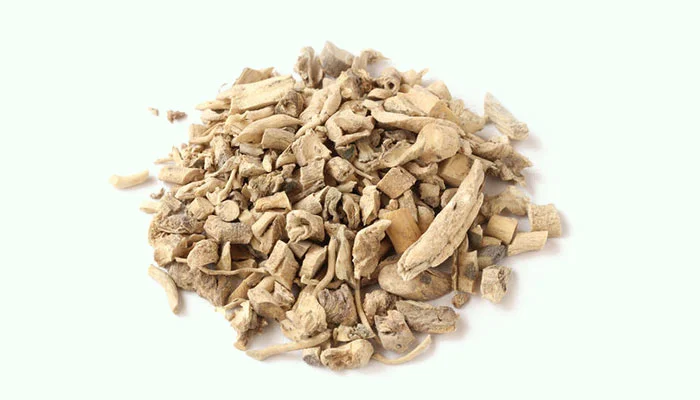What Is Bai Xian Pi
Bai Xian Pi also known as Cortex Dictamni is the root bark of Dictamnus dasycarpus, which is a perennial herb belonging to the family Rutaceae. It is a relatively practical and common Chinese herbal medicine, which first appeared in <Shennong Ben Cao Jing> in the late Western Han Dynasty (around 100 BCE).
There are 6 species of this genus, which are distributed in Europe and Asia. Two of them are distributed in China, namely Dictamnus dasycarpus and D. angustifolius.
Dictamnus dasycarpus is cold and drought-tolerant, and likes sunlight and a warm and humid environment. They often grow on sunny hillsides, forest edges, low shrubs or grasslands, and have been artificially planted. They can be found in China, North Korea, Mongolia, and the Russian Far East.
In the spring and autumn of each year, people collect the roots of Dictamnus dasycarpus, remove the sand and their coarse bark, peel off their root bark, cut them into thick slices, dry them, and make them into Chinese herbal medicines.

Bai Xian Pi contains dictamnine, y-fagarine, skimmianine, isodictamnine, preskimmianine, trigonelline, choline, limonin, dictamnolactone, evodine, fraxinellon, obakunone, wogonin, luteolin, β-elemol, dictamnol, β-sitosterol, daucosterol, stigmasterol, rutin, and volatile oils.
According to the Chinese Pharmacopoeia, the medicinal nature of Bai Xian Pi is relatively cold, with a bitter taste. It has a certain therapeutic effect on the pathological changes of the spleen, stomach, and bladder meridians.
Generally, the grayish Bai Xian Pi with layered cross-section and no wooden heart is preferred.
According to the Chinese Pharmacopoeia, the medicinal nature of Bai Xian Pi is relatively cold, with a bitter taste. It has a certain therapeutic effect on the pathological changes of the spleen, stomach, and bladder meridians.
In traditional Chinese medicine (TCM), it is often used to clear heat and dry dampness, dispel wind and remove toxins, relieve skin dryness, itching, desquamation, pigmentation, and treat eczema, rubella, scabies, psoriasis, vitiligo, vaginitis, jaundice, gastric and duodenal ulcers, rhagades of hands and foot, and arthralgia caused by wind-damp-heat.
There are about 50 kinds of Chinese medicine prescriptions containing it, such as Bai Dian Feng Jiao Nang, Fu Fang Qing Dai Wan, and Shi Du Qing Capsule.
Benefits
- Anti-inflammation, inhibiting dinitrofluorobenzene-induced rat ear swelling and ovalbumin-induced rat foot swelling.
- Anti-oxidation, scavenging DPPH free radicals and ABTS free radicals.
- Inducing the Mythimna separata to produce deformed pupae and prolonging the hatching of eggs.
- Shortening bleeding time and clotting time, reducing bleeding.
- Reducing liver damage induced by CCL4 and protecting the liver.
- Improving the tolerance of hippocampal cells to glutamate-induced oxidative damage and reducing cell neurotoxic damage.
- Treating skin ulcers and rashes oozes yellow liquid caused by damp-heat.
- Relieving dry skin and itching, treating eczema, rubella, and scabies.
- Clearing heat and drying dampness, treating jaundice and brownish urine caused by damp-heat.
- Dispelling wind, treat joint swelling and pain caused by wind-damp-heat.
- Inhibiting the proliferation of human liver cancer cell line SMMC-7721, and inducing apoptosis of pancreatic cancer MDA PANC-28 cells, colon cancer SW480 cells, and human lung cancer cell line A549.
- Studies have found that its water extract has a significant inhibitory effect on the formation of early atherosclerotic lesions in ApoE-/- mice.
- Its water infusion can inhibit many pathogenic fungi, such as Trichophyton violaceum, trichophyton con-centricum, E. floccosum, and Nocardia asteroides.
Combinations
- It can be used in combination with Cang Zhu (Rhizoma Atractylodis), Ku Shen (Radix Sophorae Flavescentis), Lian Qiao (Fructus Forsythiae), etc. to alleviate skin ulcers and rashes oozes yellow liquid caused by damp-heat.
- It can be used in combination with Ku Shen (Radix Sophorae Flavescentis), Fang Feng (Radix Saposhnikoviae), Di Fu Zi (Kochiae Fructus), etc. to treat rubella, tinea, and scabies.
- It can be used in combination with Yin Chen (Herba Artemisiae Scopariae), Zhi Zi (Fructus Gardeniae), Hu Zhang (Polygoni Cuspidati Rhizoma et Radix), etc. to treat jaundice and brownish urine caused by damp-heat.
- It can be used in combination with Cang Zhu (Rhizoma Atractylodis), Huang Bai (Cortex Phellodendri), Yi Yi Ren (Semen Coicis), etc. to dredge meridians and alleviate joint swelling and pain.
- The topical application of the decoction is composed of Bai Xian Pi, Di Gu Pi (Cortex Lycii), Ku Shen (Radix Sophorae Flavescentis), Gan Cao (Licorice Root), etc. to treat chapped hands and feet.
Side Effects
- At present, there is no literature report that Bai Xian Pi has toxic effects, and no data is showing that taking it will cause serious adverse reactions.
Precautions and Warnings
- The dosage of Bai Xian Pi should be controlled at 5-10g.
- It can be made into decoctions, lotions, or ground for external use.
- It should not be taken at the same time as Jie Geng (Radix Platycodi), Bi Xie (Rhizoma Dioscoreae Hypoglaucae), Fu Ling (Poria), or Hai Piao Xiao (Os Sepiae).
- People who are allergic to Bai Xian Pi should not take it.
- Patients with hypertension or hepatic insufficiency should not take it.
- Patients with deficiency-cold in the spleen and stomach should not take it.
- Pregnant women and children should not take it.
